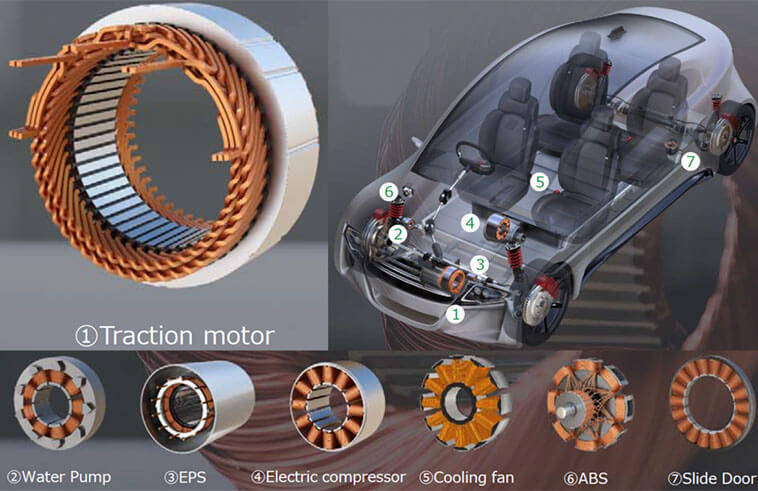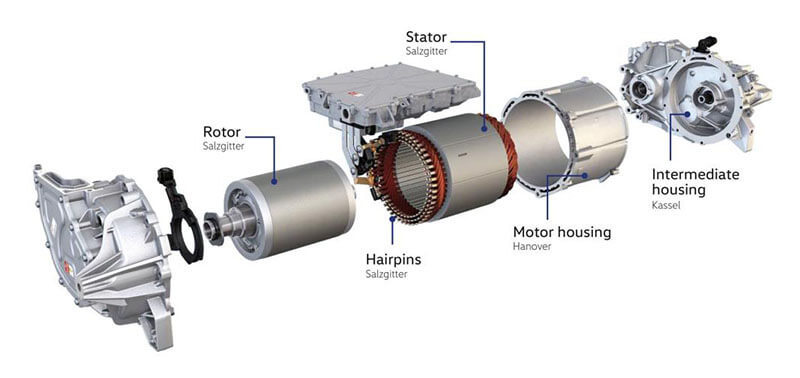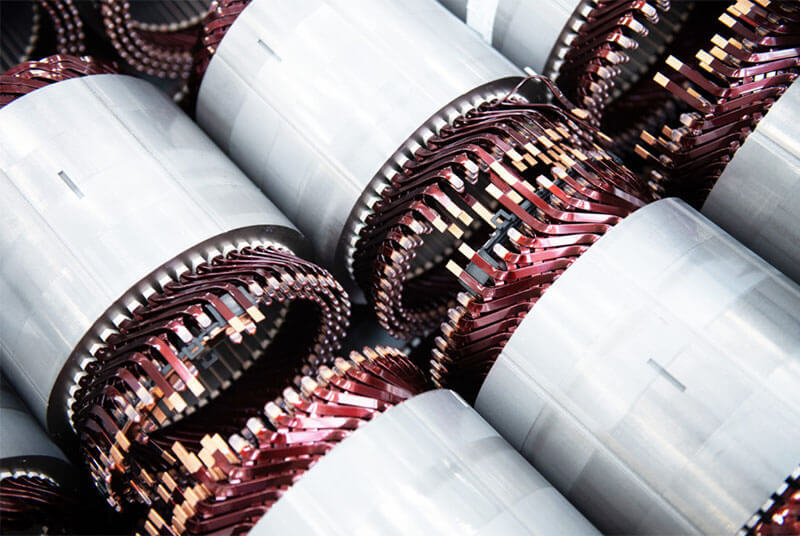
News Center
The Development Status of Automobile Hairpin Winding Technology
Published on.
2021-10-08 09:39
Source
Summary: With the development of electric drive systems for new energy vehicles, higher requirements have been put forward for the power density and efficiency of vehicle drive motor. The hairpin motor winding permanent magnet synchronous motor has a higher slot full rate than the traditional round wire motor. It has advantages in power, efficiency, and volume, and meets the development needs of the new energy vehicle field. This article will introduce the current development status of automotive hairpin winding permanent magnet synchronous motor, including the current status of domestic and foreign industries, motor characteristics, and combined characteristics and current research.

After years of research and development, permanent magnet synchronous motor for vehicles has been designed with round copper wires for the development of miniaturization, integration, and high power density of electric drive systems for new energy vehicles. With the advancement of production technology, in order to meet the needs of the new energy market, motor windings have been designed develop to the hairpin winding design. The use of hairpin winding can increase the slot full rate of the motor winding, thereby improving the efficiency and power density of the motor, but it has the characteristics of complex production processes and high requirements for copper wires and development restrictions.
1. Industry Status
Before 2010, the hairpin motor developed and produced by foreign companies were used in mass-produced vehicles, and patents were applied for protection. In 2007, the Chevrolet Volt model was equipped with a hairpin motor developed and produced by the Remy Company. The hairpin motor developed by Japan’s HITACHI was installed in Nissan’s Leaf in 2013. Toyota released the 4th generation Prius in 2015, which is equipped with Denso hairpin motor. Auto parts supplier BorgWarner acquired Remy company in 2015, thereby obtaining drive motor R&D technology and production capacity, and matching and integrating with the electric drive gearbox eGearDrive, becoming an electric drive axle eDM module. The Porsche Taycan was launched in 2019. It is equipped with a high-performance hairpin motor with a maximum torque of 550Nm and a maximum speed of over 16000rpm, as well as a two-speed dual-clutch transmission. UP to now, hairpin motor technology was first applied by foreign car companies and has achieved a good demonstration effect in the new energy drive motor market.
For the development of domestic hairpin winding technology, many companies first need to face the problem of professional barriers. Overseas companies already have mature hairpin motor mass production technology, but the core patents belong to a few companies such as Remy and Denso. In addition, the manufacturing process still needs to rely on some foreign technical support, and the cost of automatic motor production schemes is difficult to control before the technology automation matures. The hairpin motor industry in our country started late and is in a continued mature stage of development. It needs to face the influence of foreign companies' patent protection, and it needs to go through continuous technical research and breakthroughs. In the face of fierce competition with overseas companies, companies and universities related to motor R&D and production technology still have a lot of room for development and improvement in motor performance, electric drive integration, and manufacturing technology.

2. Features of Hairpin Motor
The main difference in structure between the hairpin motor and the traditional permanent magnet synchronous motor is the stator assembly, which uses a hairpin winding instead of a round wire winding to design the motor.
The advantages of hairpin motor for the whole vehicle include providing better acceleration performance, better energy saving effect, lower noise, and can improve the performance of the whole vehicle.
A. High power density: Since the round wire has become a flat wire, the copper slot full rate can be increased by more than 20% to about 70% under the condition of the same winding space. In order to avoid damaging the copper wire during the raw tea process, the traditional round wire motor generally keeps the height of the winding end relatively long, while the hairpin motor can make the end shorter during processing because the winding is a formed flat copper wire. The height of the part is lower, the volume is reduced and the copper material is saved. Therefore, under the same power requirement, the motor has a smaller volume and uses less materials, thereby achieving lighter weight and higher power density.
B. Higher efficiency: the copper consumption of the motor accounts for more than 60% of the motor loss. The improvement of the winding slot full rate is equivalent to the thickening of the wire, which increases the cross-sectional area of a single winding. According to the inverse relationship between the conductor resistance and the cross-sectional area, the wire resistance decreases, and the copper loss of the motor is proportional to the winding resistance. Therefore, under the same design requirements, the copper loss of the motor is lower, and the maximum efficiency can be increased by 1%.
C. Good temperature performance: Because the stator winding gap is small, the contact area between the winding rectangular copper wire and the iron core slot becomes larger, and because the wire resistance becomes smaller, under the same design requirements, the heat dissipation capacity is better, the heat generation is smaller, and the same design winding temperature rise of the hairpin motor is 5-10% lower than that of the round copper wire motor. However, it must be pointed out that after the power density requirements are increased, the size of the motor is more compact, and the performance requirements of the motor thermal management system are higher.
D. Low vibration and noise: The consistency of the hairpin winding in the slot and the end is better than that of the round wire, and the slot size can be smaller because of the hairpin winding, which makes the stator have better rigidity, reduces the cogging torque, and can be reduced Vibration and noise.
Although the hairpin motor has so many advantages in performance, it also has some shortcomings and development limitations.
A. Complex process: The production process of the hairpin motor is more complicated and requires high precision. It is impossible to achieve mass production through manual manufacturing, so the initial production line investment is relatively large. The automatic manufacturing process of the hairpin stator includes slotting paper, manufacturing hairpin, shaping, insulation treatment, etc. At present, domestic production equipment is still in its infancy, and it is necessary to get rid of dependence on foreign suppliers in order to reduce production costs. This is a prerequisite for large-scale popularization.
B. Great skin effect: Due to the large cross-sectional area of the hairpin copper wire, when the current frequency becomes higher, the skin effect of the current will concentrate the current on the surface of the conductor, causing the AC copper consumption of the winding to increase, thereby reducing the efficiency.
C. High copper wire requirements: The hairpin winding needs to bend the rectangular copper wire with an insulating layer, unlike traditional windings that are wrapped after forming, so the insulating layer is easily damaged during the forming process, which has a higher quality of the copper wire Requirements.
The driving motor with the high power density and high efficiency also has the problem of difficulty in design and manufacturing. Therefore, pain points such as professional manufacturing equipment and production technology have become barriers to the industrialization of hairpin motor, which is also the reason why large-scale applications have not been realized. Regarding the disadvantages and development restrictions of hairpin motor, scholars at home and abroad have carried out targeted research.

3. Research status of hairpin motor:
A. Loss characteristics study.
Since the hairpin stator uses flat copper wire, it will be affected by the skin effect when the current is large, causing copper consumption to increase. In order to study the effect of skin effect on the total energy consumption of hairpin motor, the research uses driving simulation method to conduct motor test to evaluate the energy demand of the motor in driving conditions and quantifies the loss characteristics of the hairpin winding due to skin effect. Some scholars study the loss characteristics to optimize the winding structure or propose an improved design. The selection scheme can reduce the motor loss by calculating the loss related to the geometric size of the flat wire and the hairpin connection mode, combined with the analysis of the electromagnetic coupling simulation software. In addition, the automatic selection analysis software is designed in the research to analyze the winding configuration generated by different combinations of pole numbers and slot numbers, considering the loss characteristics of each configuration and the advantages and disadvantages of the connection method, to select the winding configuration to improve the efficiency of the motor.
B. Insulation performance analysis.
The hairpin winding adopts enameled copper wire. The winding process needs to go through complex processes such as forming, inserting, twisting, and welding during the production process. Therefore, it is necessary to conduct research on the insulation performance of the enameled wire, analyze and improve its insulation performance. The study puts forward a transient voltage model that combines the characteristics of the new hairpin motor winding, which can be used to analyze and optimize the design of the winding insulation layer. Partial discharge behavior of winding enameled wire, analysis of insulation performance of insulating layer. In addition, in order to analyze the insulation performance of the winding during its life cycle, scholars consider the mechanical stress and thermal stress experienced by the winding. Perform an aging test to evaluate the insulation performance of the hairpin winding.
C. Processing technology research.
Although the hairpin motor winding process is complicated, after optimization, when the output reaches a certain scale, the production cost of each stator winding is lower than that of the traditional round winding. This shows that the hairpin winding is more suitable for large-scale production. After each flat copper wire in the winding undergoes bending and other forming processes, it’s installed on the stator and welded to form a winding. Therefore, the quality and production efficiency of the copper wire forming and welding process have attracted much attention. In order to quickly detect the surface defects of the hairpin copper wire after forming and the welding quality of a large number of welding points, machine vision and machine learning defect-recognition methods can be combined to improve inspection efficiency and reduce inspection costs. In addition, some studies have proposed how to apply laser welding technology to improve the production efficiency of hairpin winding and welding quality.
D. Thermal management program research.
Hairpin motor has the characteristics of high power density, and the size of the motor with the same power requirement is smaller. This represents higher requirements for the thermal management system of the motor. In addition to the optimization of the traditional wind and water channel liquid cooling scheme, scholars have proposed a new type of cooling scheme according to the characteristics of the hairpin motor. According to the characteristics of high consistency and large heat generation at the end of the hairpin motor, the oil injection cooling test of the winding end is carried out, and the cooling effect of different factors such as the amount of fuel injection, and practical engineering application suggestions are given. Some scholars choose the direct internal cooling method of hollow flat wire. The results show that although the cooling performance is excellent, the hollow flat wire winding has more losses when used at high frequency, and the wire material is subjected to higher tension due to internal cooling, which affects durability.
Summary: The hairpin motor for automobiles has been first applied by foreign companies, and mature suppliers have been installed on many models of Toyota, GM and other brands as early as 5-10 years ago. The supporting supply of technology and materials is still in the development stage. Hairpin motor has the characteristics of high efficiency and high power density. The domestic hairpin motor R&D and manufacturing industries are still immature and are facing challenges in design and mass production. Therefore, the initial investment cost is very high. However, hairpin motor has great development potential. After the market penetration rate increases, hairpin motor will reduce the cost of the vehicle and improve the power and economy of the vehicle, thereby increasing the market power of new energy vehicles.
Keywords: Permanent magnet synchronous motor, hairpin winding, spacer factor, new energy vehicles.
Related News






